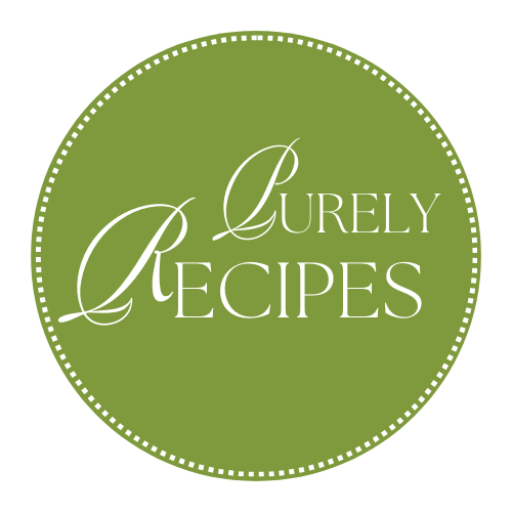Introduction
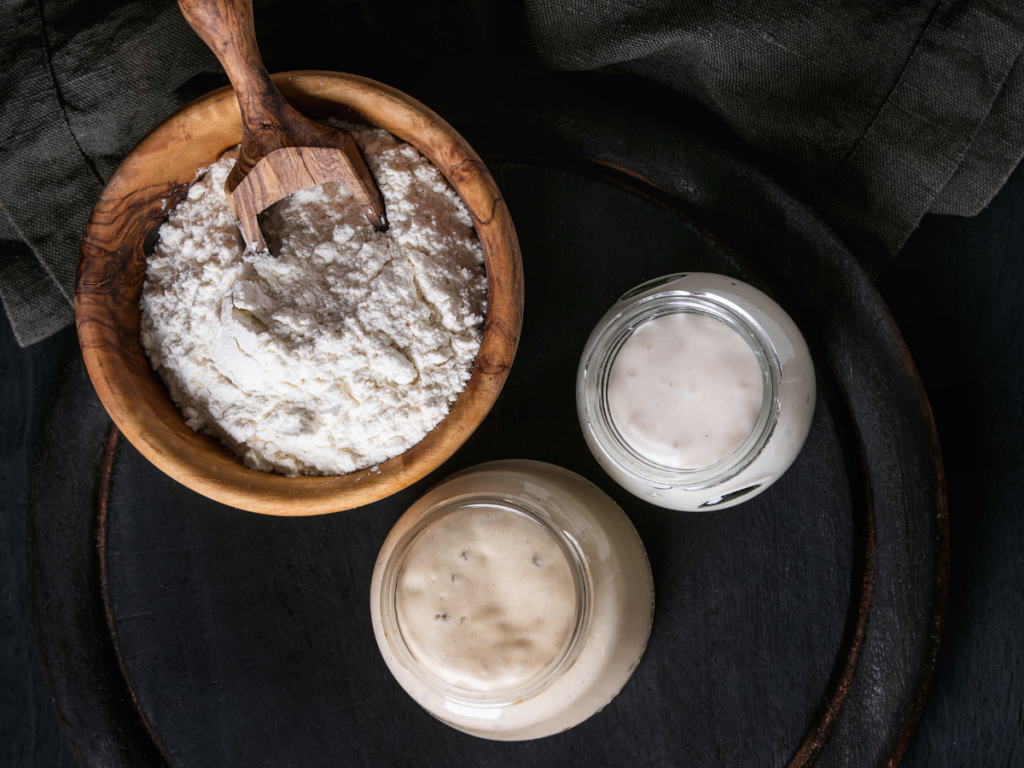
Rye flour is a distinctive and versatile ingredient in sourdough bread making, renowned for its unique flavor profile, nutritional benefits, and the rich history it brings to the baking tradition. Unlike wheat flour, rye flour contributes to a denser, more flavorful bread with a slightly sour and earthy taste, which is highly prized in many European bread varieties.
In the world of sourdough baking, rye flour offers unique challenges and opportunities. Its lower gluten content, higher fiber, and enzyme activity create a different fermentation dynamic, resulting in breads that are both robust in flavor and dense in texture. Understanding the properties and behavior of rye flour is essential for bakers aiming to produce high-quality sourdough bread.
This introduction aims to explore the role of rye flour in sourdough bread making, highlighting its distinctive characteristics, benefits, and the considerations bakers must keep in mind when working with this ancient grain. Through this exploration, we will uncover why rye flour remains a cherished component in the art of traditional bread making.
What is Rye Flour?
Rye flour is a type of flour made from rye grains. It is commonly used in baking, particularly for making bread. Rye flour has a distinct, slightly sour flavor and produces dense, dark-colored bread. It is often used in traditional European breads such as pumpernickel and rye bread.
Types of Rye Flour
Light Rye Flour: This is made from the inner part of the rye grain and has a lighter color and milder flavor. It is often used in combination with other flours.
Medium Rye Flour: This type of flour includes more of the rye grain’s outer layers, giving it a slightly darker color and stronger flavor than light rye flour.
Dark Rye Flour: Made from the whole rye grain, this flour has the strongest flavor and darkest color. It is often used in traditional rye bread recipes.
Pumpernickel Flour: This is a coarsely ground rye flour, typically used in pumpernickel bread.
Rye flour is known for its high fiber content and is considered more nutritious compared to wheat flour. It also has a lower gluten content, which makes rye bread denser and less elastic than bread made with wheat flour.
The Benefits of Rye Flour in Sourdough
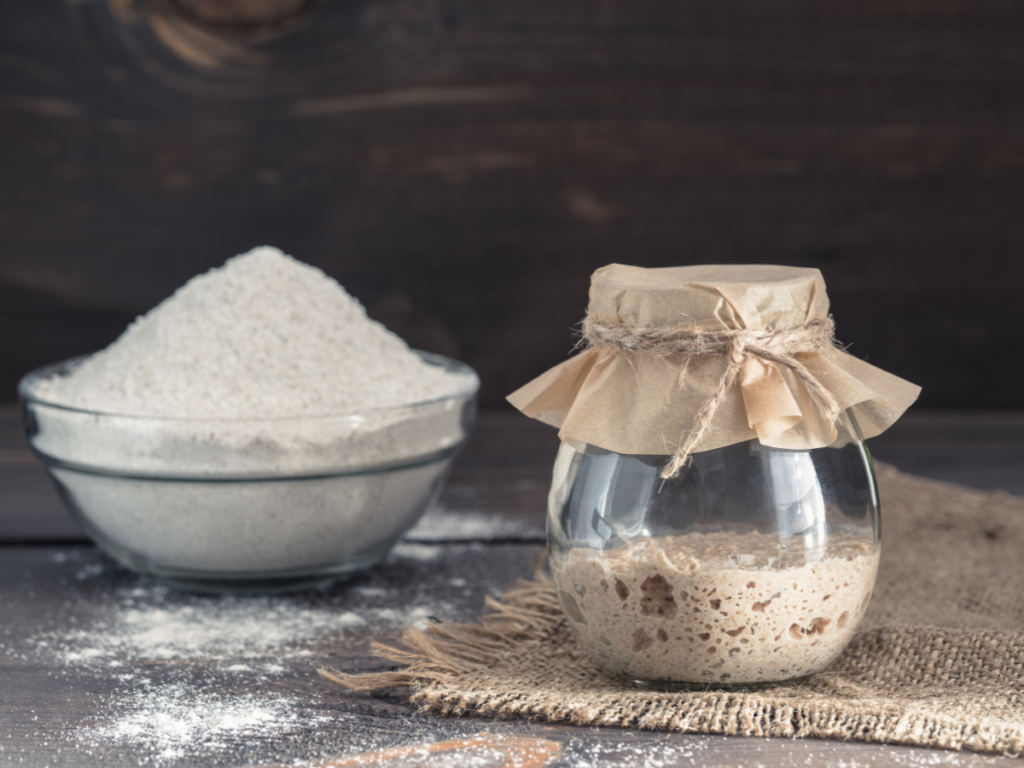
Nutritional Value
Rye flour is rich in essential nutrients, including dietary fiber, vitamins (such as B vitamins), and minerals (like magnesium, manganese, and phosphorus). Its high fiber content aids in digestion and can help maintain a healthy gut.
Enhanced Flavor
Rye flour imparts a distinctive, earthy flavor to sourdough bread. Its slightly tangy and robust taste complements the sour notes from the fermentation process, resulting in a complex and enjoyable flavor profile.
Improved Texture
The gluten structure in rye flour is different from that in wheat flour. This difference can lead to a denser, moister crumb, which many people find appealing. Rye sourdough tends to have a hearty, chewy texture that sets it apart from other breads.
Longer Shelf Life
Rye flour has hygroscopic properties, meaning it attracts and retains moisture. This can help sourdough bread stay fresher for longer periods compared to bread made solely with wheat flour.
Fermentation Benefits
Rye flour is particularly conducive to the sourdough fermentation process. The natural sugars and starches in rye are readily fermented by the wild yeast and lactic acid bacteria in a sourdough starter. This can lead to a more vigorous and stable fermentation, enhancing the bread’s rise and flavor development.
Health Benefits
The combination of rye flour and sourdough fermentation can offer several health benefits:
- Lower Glycemic Index: Rye sourdough bread typically has a lower glycemic index than wheat bread, which can help manage blood sugar levels.
- Prebiotic Properties: The fermentation process can enhance the prebiotic properties of rye, supporting beneficial gut bacteria.
- Reduced Gluten Sensitivity: Although not gluten-free, rye flour contains less gluten than wheat, and the fermentation process can further break down gluten, making it more digestible for some people.
Sustainability
Rye is a hardy grain that grows well in poor soils and harsh climates. It requires fewer pesticides and fertilizers compared to other grains, making it a more environmentally sustainable choice for flour.
Incorporating Rye Flour into Sourdough Baking
To enjoy these benefits, you can use rye flour in various proportions in your sourdough recipes. A common approach is to mix rye flour with other flours, such as whole wheat or white flour, to balance flavor and texture. Experimenting with different ratios can help you find the perfect combination for your taste preferences and baking goals.
Challenges of Working with Rye Flour

Low Gluten Content
Texture and Structure: Rye flour has a significantly lower gluten content compared to wheat flour. This results in denser and heavier bread. The gluten in rye is less elastic and more soluble, making it harder to achieve the airy texture seen in wheat bread.
Dough Handling: The dough made from rye flour can be stickier and more difficult to handle due to the lack of elasticity.
Different Hydration Needs
Rye flour absorbs more water than wheat flour, requiring adjustments in the hydration level of recipes. It can be tricky to get the right consistency, as too much water can make the dough excessively sticky and too little can make it dry and crumbly.
Fermentation
Faster Fermentation: Rye flour ferments faster due to its higher sugar content, which can lead to over-proofing if not carefully monitored. Over-proofing can result in a collapsed structure and an overly sour taste.
Gummy Texture: Rye dough is also more prone to producing a gummy texture if fermentation is not managed properly.
Flavor
Rye flour has a stronger, more distinct flavor compared to wheat. This can be an acquired taste and might not be preferred by everyone.
The flavor of rye can also become quite sour if the dough is allowed to ferment too long, which is a characteristic of traditional rye breads but may not be desirable for all bakers.
Baking
Rye bread often requires longer baking times at lower temperatures to ensure it is fully cooked through without burning the crust. This can be challenging to perfect and may require adjustments to baking methods.
The crust of rye bread tends to harden quickly, which can make it difficult to achieve a soft, chewy crust.
Additives and Enzymes
Working with rye flour often necessitates the use of additional ingredients such as caraway seeds, molasses, or other flavor enhancers to balance its robust taste.
Enzymes and other additives might be needed to improve the dough’s handling properties and overall texture, adding complexity to the recipe.
Shelf Life
Rye flour has a shorter shelf life than wheat flour due to its higher oil content, which can lead to rancidity. Proper storage in cool, dry conditions is crucial to maintain its quality.
Understanding and adapting to these challenges is key to successfully incorporating rye flour into baking practices. Bakers often need to experiment and adjust their techniques to achieve the desired results.
Baking Techniques for Rye Sourdough
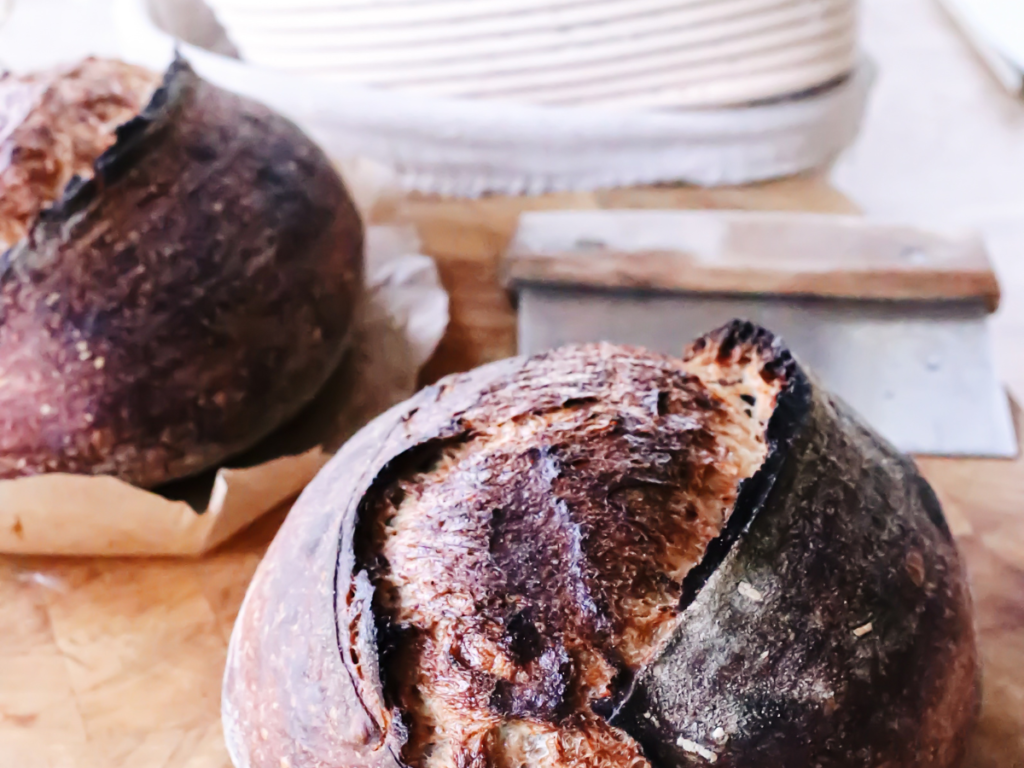
Baking rye sourdough bread involves several unique techniques due to the distinct properties of rye flour. Here’s a comprehensive guide to get you started:
Ingredients
- Rye Sourdough Starter: Ensure your starter is active and bubbly.
- Rye Flour: Whole grain or light rye flour can be used.
- Water: Use filtered or spring water for best results.
- Salt: Sea salt or kosher salt works well.
Steps and Techniques for Baking Rye Sourdough Bread
Prepare the Starter
Feed your rye sourdough starter 8-12 hours before you plan to bake. It should be active, bubbly, and at its peak.
Mix the Dough
In a large bowl, combine the following:
- 300g active rye sourdough starter
- 500g rye flour
- 350-400ml water (adjust to achieve a sticky consistency)
- 10g salt
Mix the ingredients until fully combined. The dough will be sticky and dense compared to wheat-based doughs.
Autolyse
Let the dough rest for 20-30 minutes. This helps hydrate the flour and develop gluten.
Kneading
Unlike wheat dough, rye dough doesn’t need extensive kneading due to its low gluten content. Instead, use the stretch and fold technique. Over a period of 2-3 hours, perform 3-4 sets of stretch and folds at 30-minute intervals. To stretch and fold:
- Wet your hands to prevent sticking.
- Stretch the dough from one side and fold it over to the center. Repeat on all four sides.
Bulk Fermentation
Cover the dough with a damp cloth or plastic wrap and let it ferment at room temperature for 3-4 hours, or until it has doubled in size.
Shaping
Turn the dough out onto a floured surface. Shape it into a round or oblong loaf, depending on your preference and the type of baking vessel you plan to use. Rye dough is less elastic, so handle it gently.
Final Proofing
Place the shaped dough into a proofing basket or a bowl lined with a floured cloth. Let it proof for 1-2 hours at room temperature, or overnight in the refrigerator for a slower fermentation and more developed flavor.
Scoring
Preheat your oven to 240°C (465°F) with a baking stone or Dutch oven inside. Once the oven is hot, score the top of the loaf with a sharp knife or a razor blade. This allows the bread to expand properly in the oven.
Baking
Transfer the dough to the preheated baking vessel. If using a Dutch oven, cover it with the lid. Bake for 20 minutes with the lid on (if using a Dutch oven) to trap steam, then remove the lid and bake for another 20-30 minutes, or until the loaf is deep brown and sounds hollow when tapped on the bottom.
Cooling
Let the bread cool completely on a wire rack before slicing. This allows the crumb to set and improves the texture.
Tips
Hydration
Rye flour absorbs more water than wheat flour. Adjust the water content to achieve a sticky but manageable dough.
Fermentation
Rye ferments faster than wheat. Keep an eye on the dough during bulk fermentation and proofing to avoid over-proofing.
Flavor
Rye sourdough has a distinct, robust flavor. For a milder taste, you can mix rye flour with wheat flour in a 50/50 ratio.
By following these techniques, you’ll be able to bake a delicious and authentic rye sourdough bread with a rich flavor and satisfying texture. Enjoy your baking!
Incorporating Rye Flour into Your Recipes
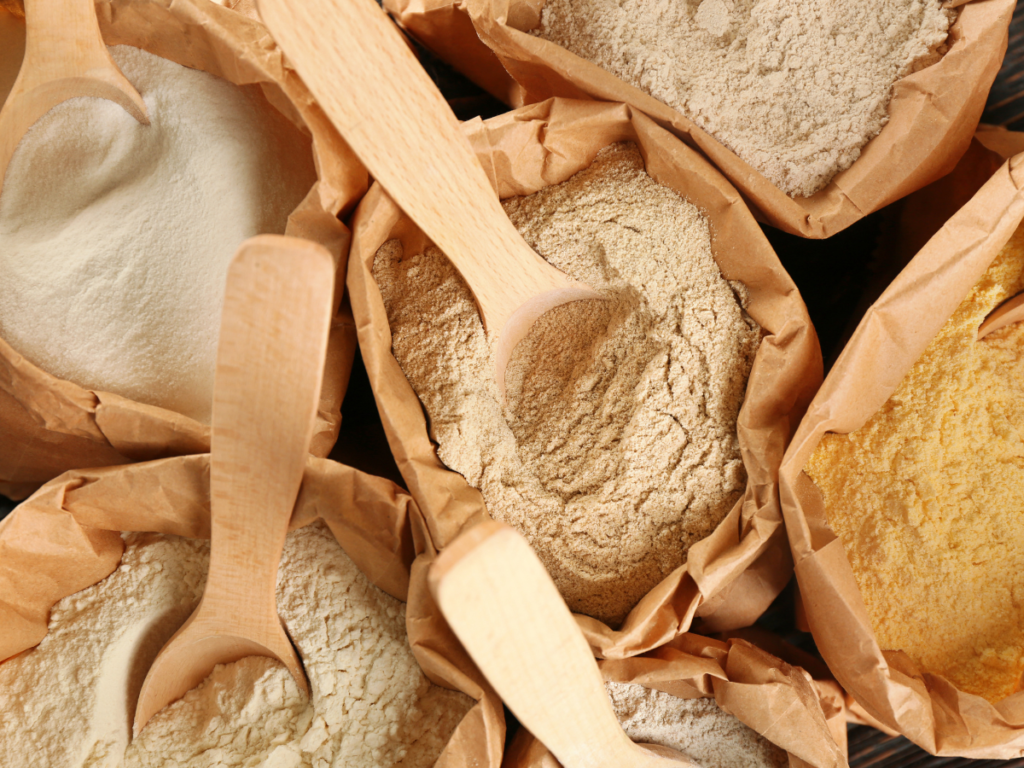
Incorporating rye flour into your recipes can add a unique depth of flavor, texture, and nutritional benefits. Rye flour is known for its robust, slightly tangy taste and its ability to produce dense, hearty baked goods. Here’s how to effectively use rye flour in various recipes:
Understanding Rye Flour
Types of Rye Flour:
- Light Rye Flour: Finely ground and lighter in color; produces a milder flavor and lighter texture.
- Medium Rye Flour: A balance between light and whole grain, offering a medium color and flavor.
- Whole Grain Rye Flour: Contains the entire rye kernel, providing the most robust flavor and highest nutritional value.
Characteristics:
- Lower gluten content compared to wheat flour, resulting in denser baked goods.
- High in dietary fiber, vitamins, and minerals.
- Absorbs more water, requiring adjustments in hydration levels.
Substituting Rye Flour
Partial Substitution: Replace up to 25-50% of the wheat flour in your recipe with rye flour to add flavor and nutrition without significantly altering the texture.
- Example: For a recipe calling for 400g of wheat flour, use 200-300g wheat flour and 100-200g rye flour.
Full Substitution: When using only rye flour, expect a denser texture. Adjust hydration and kneading techniques accordingly.
- Increase hydration by 10-15% as rye flour absorbs more water.
Recipes and Techniques
Breads:
- Rye Sourdough: Use a rye starter and a higher hydration dough. Follow traditional sourdough techniques, focusing on stretch and fold rather than kneading.
- Rye Sandwich Bread: Combine rye flour with bread flour for a balanced loaf. Add ingredients like honey, molasses, or caraway seeds for flavor.
Pastries and Sweets:
- Rye Cookies: Substitute 25-50% of the all-purpose flour with rye flour. This works well with recipes like chocolate chip cookies or ginger snaps.
- Rye Muffins: Replace a portion of the wheat flour with rye flour. Add fruits, nuts, or spices to complement the rye’s flavor.
Savory Bakes:
- Rye Crackers: Mix rye flour with whole wheat or all-purpose flour, olive oil, water, and salt. Roll thin and bake until crisp.
- Rye Pancakes: Use a blend of rye and all-purpose flour. The rye flour adds a nutty flavor that pairs well with savory toppings.
Tips for Baking with Rye Flour
- Hydration: Increase the water content in your dough or batter. Rye flour’s higher absorption rate necessitates this adjustment.
- Mixing and Kneading: Avoid over-kneading rye dough. Use stretch and fold techniques to develop the dough structure gently.
- Fermentation: Rye dough ferments faster than wheat dough. Monitor proofing times closely to prevent over-proofing.
- Flavor Pairings: Rye’s robust flavor pairs well with bold ingredients like caraway seeds, molasses, honey, nuts, dried fruits, and spices such as cinnamon and ginger.
Example Recipe: Rye Sourdough Bread
Ingredients:
- 300g active rye sourdough starter
- 500g rye flour
- 350-400ml water
- 10g salt
Instructions:
- Mix all ingredients until combined.
- Let the dough rest for 20-30 minutes (autolyse).
- Perform stretch and fold every 30 minutes for 2-3 hours.
- Bulk ferment until doubled in size.
- Shape the dough and proof for 1-2 hours or overnight in the fridge.
- Preheat oven to 240°C (465°F). Score and bake for 40-50 minutes, with the first 20 minutes under steam.
- Cool completely before slicing.
Incorporating rye flour into your recipes can elevate the flavor and nutritional profile of your baked goods. Experiment with different proportions and recipes to find your perfect balance.
Conclusion
Is Rye Flour Good for Sourdough Bread?
Rye flour is an excellent choice for sourdough bread, offering unique benefits that distinguish it from other flours. Its distinctive, robust flavor and dense texture contribute to a hearty and satisfying loaf. The natural fermentation process of sourdough pairs exceptionally well with rye, enhancing its earthy notes and providing a delightful tang.
Moreover, rye flour is rich in nutrients and fiber, making it a healthier option compared to refined wheat flours. Its lower gluten content may also be beneficial for those with mild gluten sensitivities. While working with rye flour can be challenging due to its stickiness and different hydration needs, mastering these techniques can yield impressive results.
Incorporating rye flour into your sourdough baking can diversify your bread repertoire and introduce you to the rich traditions of rye-based breads enjoyed across many cultures. Whether you are a seasoned baker or a novice, experimenting with rye flour in your sourdough can be a rewarding and delicious endeavor.
FAQs
What Does Rye Flour Do in Sourdough?
Rye flour plays a significant role in sourdough baking for several reasons:
- Fermentation Speed: Rye flour ferments faster than wheat flour due to its higher levels of amylase, an enzyme that breaks down starches into sugars. This can help to kickstart the fermentation process in a sourdough starter.
- Flavor: Rye flour contributes a distinct, slightly sour flavor to the bread, which can enhance the overall taste of the sourdough.
- Nutrient Content: Rye flour is rich in nutrients and minerals, which can feed the natural yeast and bacteria in the sourdough starter, promoting a healthy and active fermentation process.
- Moisture Retention: Rye flour has a higher ability to retain moisture, which can result in a more moist and dense crumb in the final bread.
What is the Best Flour to Use for Sourdough Bread?
The best flour to use for sourdough bread depends on the desired characteristics of the bread. However, a combination of the following is often recommended:
- Bread Flour: This flour has a higher protein content, which helps develop a strong gluten network. This is essential for the bread’s structure and chewiness.
- Whole Wheat Flour: Including whole wheat flour can add flavor, nutrition, and fermentation activity due to its bran and germ content.
- Rye Flour: Adding rye flour can enhance the sourdough’s flavor and fermentation speed. It’s particularly useful in the starter to boost activity.
A typical approach is to use a mix of bread flour and whole wheat or rye flour to balance structure and flavor.
Is Dark or Light Rye Flour Better for Sourdough Bread?
Both dark and light rye flour have their advantages in sourdough baking:
- Light Rye Flour:
- Texture: It provides a milder flavor and a lighter texture, which can be more appealing if you want a less dense bread.
- Fermentation: Light rye ferments more quickly than dark rye due to lower fiber content.
- Dark Rye Flour:
- Flavor: It offers a more intense, robust flavor and a darker color.
- Nutrition: Dark rye is higher in fiber and nutrients since it contains more of the whole grain.
The choice between dark and light rye flour depends on your preference for flavor intensity and bread density. Many bakers use a combination of both to achieve a balanced result.
Is Bread Flour Better Than Rye Flour for Sourdough Starter?
Incorporating rye flour can be beneficial for the following reasons:
- Fermentation Activity: Rye flour can speed up fermentation and increase the activity of the starter.
- Nutrient Boost: It provides a rich nutrient base for the yeast and bacteria.
To enhance the user experience and SEO for the article titled “Is Rye Flour Good for Sourdough Bread?” on the Purely Recipes website, we can incorporate strategic internal links to relevant articles. This approach will not only provide additional value to readers but also help in boosting the site’s search engine rankings by demonstrating content interconnectedness and depth. Below are suggestions for internal linking using rich anchor texts:
- Understanding Gluten in Sourdough Bread: Link to “Is Sourdough Bread OK If You Are Gluten-Free?” to help readers understand how rye flour, a low-gluten option, can benefit those with gluten sensitivity, yet still desire the unique taste and texture of sourdough.
- Sourdough Bread Recipes: Incorporate a link to “Gluten-Free Sourdough Bread Recipe” which provides an alternative recipe for those looking to avoid traditional wheat flours.
- Rye Sourdough Recipe: Direct readers to “Sourdough Rye Bread Recipe” where they can find a specific recipe using rye flour, thus demonstrating practical application of the discussed topic.
- Starting with Sourdough: For readers interested in beginning their sourdough journey, link to “What Is the Best Gluten-Free Flour to Use for Sourdough Starter?” which discusses various flour options including rye.
- Troubleshooting Sourdough Bread Issues: A link to “Why Won’t My Gluten-Free Sourdough Bread Rise?” can provide readers facing issues with their sourdough rise a detailed troubleshooting guide.
- Maintaining a Sourdough Starter: Add a reference to “How Do You Keep a Gluten-Free Sourdough Starter?” for tips on maintaining a starter that can be used with rye flour.
